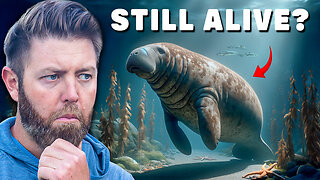Premium Only Content

Crocodile growl
Crocodiles (lat. Crocodilia) are a detachment of secondary aquatic animals of the class of reptiles from the clade eusuchia, which in turn, together with many intermediate clades, belongs to the clade crurotarza or pseudosuchia. Of living organisms, the closest relatives of crocodiles are birds, descendants of the sister branch of archosaurs. Although the word “crocodile” is most correct to refer to representatives of the family of true crocodiles, in general this term can be used to refer to any representatives of the order, which also includes alligators (alligators and caimans), gharials and some of its basal representatives. Often, "crocodiles" are called any crocodilomorphs (Crocodylomorpha), which is a mistake against the background of modern taxonomy of this group of reptiles. In the modern volume of this systematic group, crocodiles first appeared 83.5 million years ago in the late Cretaceous period. The modern detachment includes at least 15 species of true crocodiles (family Crocodylidae), 8 species of alligators (family Alligatoridae) and 2 species of gharials (family Gavialidae, sometimes abolished to a subfamily within the family of true crocodiles[1][2]).
Crocodiles have a large, dense, lizard-like body, an elongated and flattened muzzle, laterally compressed tails, and eyes, ears, and nostrils located on the top of the head. They are good swimmers and can move fairly quickly on land. Their skin is very thick and covered with non-overlapping scales. Most modern crocodiles have a complex dentition of teeth that differ in shape, size and function (heterodontism), as well as voluminous jaw muscles that provide great bite force. But some species have distinctive cranial adaptations due to feeding habits: a good example is the narrow jaws and almost homodont dentition of gharials.
Crocodiles have a four-chambered heart with a complete ventricular septum and, like birds, a unidirectional cycle of the airflow system in the lungs. However, at the same time, crocodiles are cold-blooded animals and their circulatory system retains the ability to mix arterial and venous blood due to the presence of a panizzian foramen between the left and right aortic arches. It is now believed that cold-bloodedness is a secondarily acquired feature of this group, since the ancestors of crocodiles, like other developed archosaurs, had an increased metabolic rate compared to modern reptiles and were most likely warm-blooded. Thus, features such as the ability to hold limbs relatively directly under the body, a four-chambered heart, and a respiratory system more developed than most other modern reptiles are not progressive signs of crocodiles, but a simplification of organization relative to the ancestral state.
Crocodiles are found mostly in tropical lowlands, but alligators are found in colder regions in the southeastern United States and the Yangtze River in China. All current crocodiles are specialized semi-aquatic predators, feeding on a wide range of aquatic, near-aquatic, and watering animals. Some species, such as the Gangetic gharial, have a rather narrow food spectrum. Crocodiles tend to be solitary and territorial animals, although many species are generally tolerant of their congeners. During breeding, dominant males always stick to their territory and are usually polygamous with females. Females lay their eggs in pits or mounds and take care of their young for a while. Crocodiles are known to attack humans and are the most dangerous large predators to humans. The largest number of attacks occur from the side of the Nile crocodile. It is followed by combed and marsh crocodiles. In the New World, the sharp-snouted crocodile and the black caiman are responsible for the largest number of attacks. Crocodiles were revered wherever they live. Artistic and literary representations of crocodiles have appeared in cultures around the world dating back to at least the time of ancient Egypt.sea. travel, world, nature, volcanoes, aquarium fish
-
 0:09
0:09
Perjalanan
3 years agocrocodile river
37 -
 2:10
2:10
Wild Animal World
3 years agoCrocodile
22 -
 2:37:08
2:37:08
TheSaltyCracker
9 hours agoTrump is The People's Champ ReeEEeE Stream 04-13-25
162K210 -
 4:24:35
4:24:35
Due Dissidence
18 hours agoDave Smith and Douglas Murray THROW DOWN, Judge OK's Khalil Removal, Maher Dishes on Trump Summit
49.8K47 -
 2:33:02
2:33:02
Nerdrotic
12 hours ago $22.22 earnedMysteries of Mars with Mike Bara | Forbidden Frontier 098
87.4K24 -
 3:05:07
3:05:07
IsaiahLCarter
8 hours agoApostate Radio #009: Standing Up with Eric Abbenante
39.6K2 -
 11:53
11:53
Forrest Galante
7 hours agoIs This Giant Extinct Sea Cow Still Alive?
43.2K8 -
 1:14:47
1:14:47
Josh Pate's College Football Show
10 hours ago $6.91 earnedTennessee & Nico Disaster | Portal Chaos Ahead | Biggest “What-Ifs” | Truth About Big Noon Kickoff
57.7K6 -
 2:14:43
2:14:43
Tundra Tactical
10 hours ago $7.31 earned$3200 ZEV HEARTBREAKER Contest!!! TONIGHT On The Worlds Okayest Gun Live Stream
58.5K2 -
 3:52:05
3:52:05
IcyFPS
7 hours ago🟢SOLO LEVELING LIVE 🟢 PREMIUM PAYDAY | SUNDAY GUNDAY |
36.8K2